oil SKODA FABIA 2010 2.G / 5J Owner's Guide
[x] Cancel search | Manufacturer: SKODA, Model Year: 2010, Model line: FABIA, Model: SKODA FABIA 2010 2.G / 5JPages: 244, PDF Size: 29.53 MB
Page 169 of 244
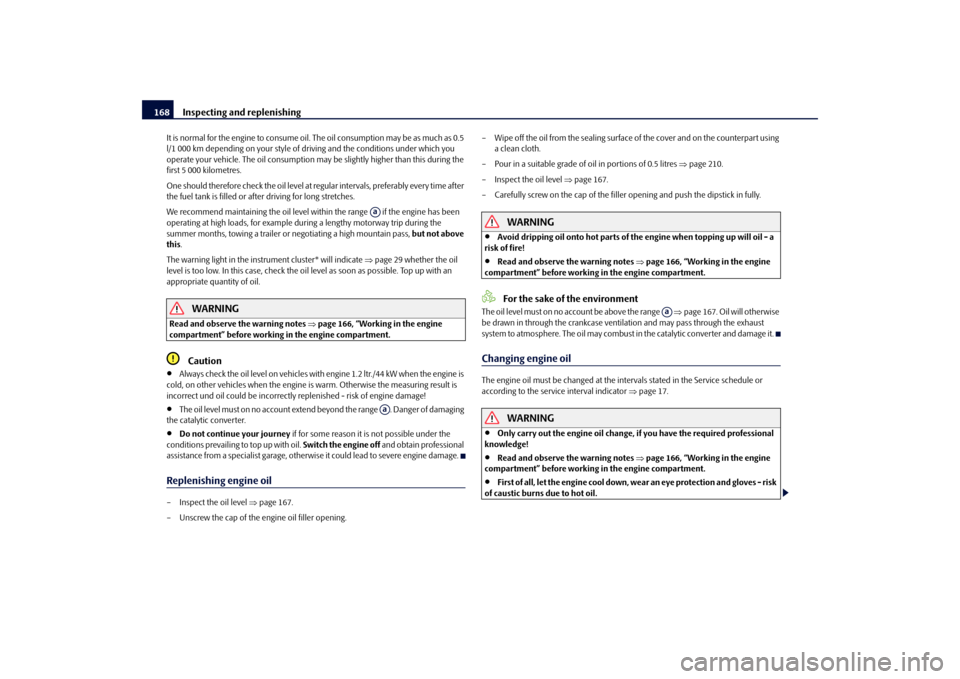
Inspecting and replenishing
168
It is normal for the engine to consume oil.
The oil consumption may be as much as 0.5
l/1 000 km depending on your style of driving and the conditions under which you operate your vehicle. The oil
consumption may be slightly hi
gher than this during the
first 5 000 kilometres. One should therefore check the oil level at regular intervals, preferably every time after the fuel tank is filled or after driving for long stretches. We recommend maintaining the oil level within the range if the engine has been operating at high loads, for example duri
ng a lengthy motorway trip during the
summer months, towing a trailer or
negotiating a high mountain pass,
but not above
this
.
The warning light in the instrument cluster* will indicate
page 29 whether the oil
level is too low. In this case, check the oil
level as soon as possible. Top up with an
appropriate quantity of oil.
WARNING
Read and observe the warning notes
page 166, “Working in the engine
compartment” before working in the engine compartment.
Caution
Always check the oil level on vehicles with engine 1.2 ltr./44 kW when the engine is
cold, on other vehicles when the engine is warm. Otherwise the measuring result is incorrect und oil could be incorrectly
replenished - risk of engine damage!
The oil level must on no account extend
beyond the range . Danger of damaging
the catalytic converter.
Do not continue your journey
if for some reason it is not possible under the
conditions prevailing to top up with oil.
Switch the engine off
and obtain professional
assistance from a specialist garage, otherwise it could lead to severe engine damage.Replenishing engine oil– Inspect the oil level
page 167.
– Unscrew the cap of the engine oil filler opening.
– Wipe off the oil from the sealing surface of the cover and on the counterpart using
a clean cloth.
– Pour in a suitable grade of oi
l in portions of 0.5 litres
page 210.
– Inspect the oil level
page 167.
– Carefully screw on the cap of the filler opening and push the dipstick in fully.
WARNING
Avoid dripping oil onto hot parts of the engine when topping up will oil - a
risk of fire!
Read and observe the warning notes
page 166, “Working in the engine
compartment” before working in the engine compartment.
For the sake of the environment
The oil level must on no account be above the range
page 167. Oil will otherwise
be drawn in through the cr
ankcase ventilation and may
pass through the exhaust
system to atmosphere. The oil may combust
in the catalytic conv
erter and damage it.
Changing engine oilThe engine oil must be changed at the intervals stated in the Service schedule or according to the service interval indicator
page 17.
WARNING
Only carry out the engine oil change, if you have the required professional
knowledge!
Read and observe the warning notes
page 166, “Working in the engine
compartment” before working in the engine compartment.
First of all, let the engine cool down, we
ar an eye protection and gloves - risk
of caustic burns due to hot oil.
AaAa
Aa
s3j8.a.book Page 168 Tuesday, April 20, 2010 1:10 PM
Page 170 of 244
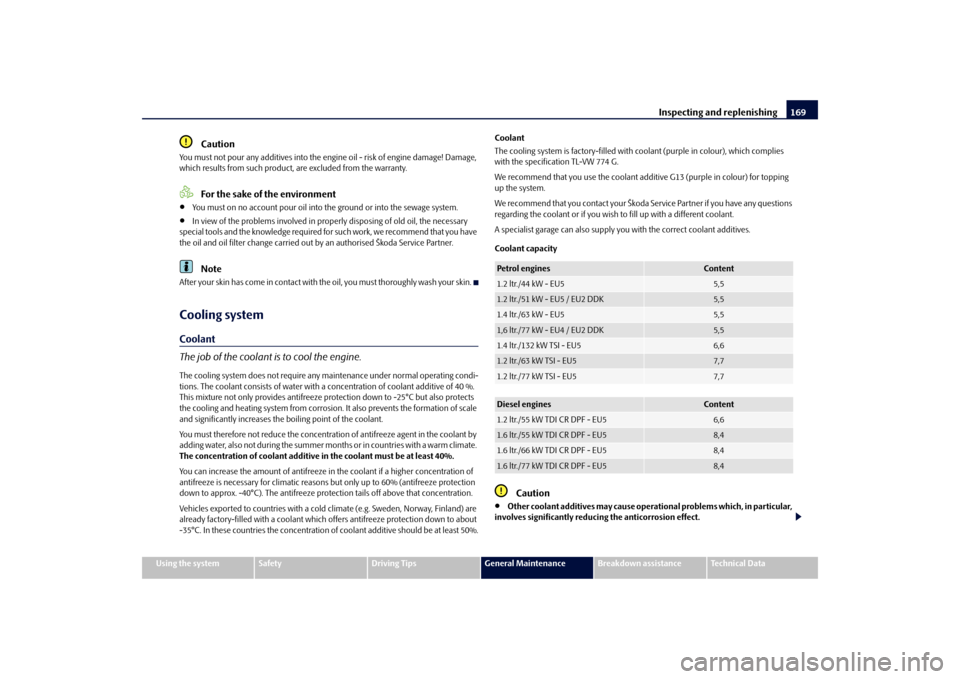
Inspecting and replenishing
169
Using the system
Safety
Driving Tips
General Maintenance
Breakdown assistance
Technical Data
Caution
You must not pour any additives into the en
gine oil - risk of engine damage! Damage,
which results from such product,
are excluded from the warranty.
For the sake of the environment
You must on no account pour oil into
the ground or into the sewage system.
In view of the problems involved in prop
erly disposing of old oil, the necessary
special tools and the knowledge required for such work, we recommend that you have the oil and oil filter change carried out
by an authorised Škoda Service Partner.
Note
After your skin has come in contact with th
e oil, you must thoroughly wash your skin.
Cooling systemCoolant The job of the coolant is to cool the engine.The cooling system does not require any maintenance under normal operating condi- tions. The coolant consists of water with a
concentration of coolant additive of 40 %.
This mixture not only provides
antifreeze protection down to -25°C but also protects
the cooling and heating system from corrosion.
It also prevents the formation of scale
and significantly increases the boiling point of the coolant. You must therefore not reduce the concentration of antifreeze agent in the coolant by adding water, also not during the summer mo
nths or in countries with a warm climate.
The concentration of coolant additive in the coolant must be at least 40%. You can increase the amount of antifreeze in the coolant if a higher concentration of antifreeze is necessary for climatic reasons
but only up to 60% (antifreeze protection
down to approx. -40°C). The antifreeze prot
ection tails off above that concentration.
Vehicles exported to countries with a cold
climate (e.g. Sweden, Norway, Finland) are
already factory-filled with a coolant which offers antifreeze protection down to about -35°C. In these countries the concentration of coolant additive should be at least 50%.
Coolant The cooling system is factory-
filled with coolant (purple in colour), which complies
with the specification TL-VW 774 G. We recommend that you use the coolant addi
tive G13 (purple in colour) for topping
up the system. We recommend that you contact your Škoda
Service Partner if yo
u have any questions
regarding the coolant or if you wish
to fill up with a different coolant.
A specialist garage can also supply
you with the correct coolant additives.
Coolant capacity
Caution
Other coolant additives may cause operational problems which, in particular,
involves significantly reduci
ng the anticorrosion effect.
Petrol engines
Content
1.2 ltr./44 kW - EU5
5,5
1.2 ltr./51 kW - EU5 / EU2 DDK
5,5
1.4 ltr./63 kW - EU5
5,5
1,6 ltr./77 kW - EU4 / EU2 DDK
5,5
1.4 ltr./132 kW TSI - EU5
6,6
1.2 ltr./63 kW TSI - EU5
7,7
1.2 ltr./77 kW TSI - EU5
7,7
Diesel engines
Content
1.2 ltr./55 kW TDI CR DPF - EU5
6,6
1.6 ltr./55 kW TDI CR DPF - EU5
8,4
1.6 ltr./66 kW TDI CR DPF - EU5
8,4
1.6 ltr./77 kW TDI CR DPF - EU5
8,4
s3j8.a.book Page 169 Tuesday, April 20, 2010 1:10 PM
Page 171 of 244
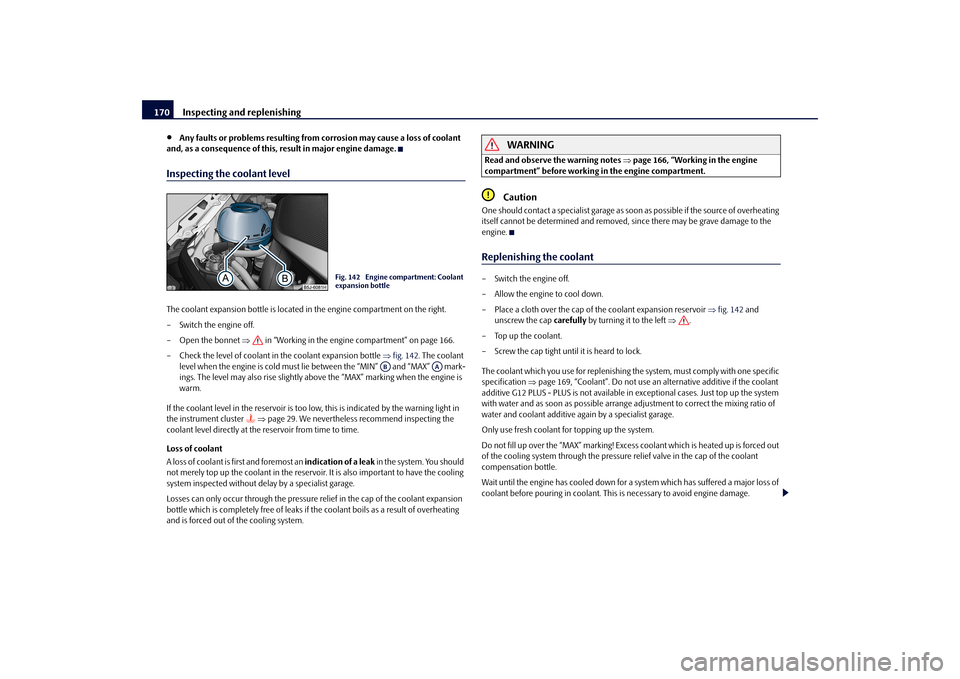
Inspecting and replenishing
170
Any faults or problems resulting from corrosion may cause a loss of coolant
and, as a consequence of this,
result in major engine damage.
Inspecting the coolant levelThe coolant expansion bottle
is located in the engine compartment on the right.
– Switch the engine off.– Open the bonnet
in “Working in the engine compartment” on page 166.
– Check the level of coolant in the coolant expansion bottle
fig. 142
. The coolant
level when the engine is cold must lie between the “MIN” and “MAX” mark- ings. The level may also rise slightly ab
ove the “MAX” marking when the engine is
warm.
If the coolant level in the reservoir is too lo
w, this is indicated by the warning light in
the instrument cluster
page 29. We nevertheless recommend inspecting the
coolant level directly at the reservoir from time to time. Loss of coolant A loss of coolant is first and foremost an
indication of a leak
in the system. You should
not merely top up the coolant in the reservoir.
It is also important to have the cooling
system inspected without delay by a specialist garage. Losses can only occur through
the pressure relief in the cap of the coolant expansion
bottle which is completely free of leaks if
the coolant boils as a
result of overheating
and is forced out of the cooling system.
WARNING
Read and observe the warning notes
page 166, “Working in the engine
compartment” before working in the engine compartment.
Caution
One should contact a specialist garage as s
oon as possible if the source of overheating
itself cannot be determined and removed,
since there may be grave damage to the
engine.Replenishing the coolant– Switch the engine off. – Allow the engine to cool down.– Place a cloth over the cap of the coolant expansion reservoir
fig. 142
and
unscrew the cap
carefully
by turning it to the left
.
–Top up the coolant.– Screw the cap tight until it is heard to lock. The coolant which you use for replenishing the system, must comply with one specific specification
page 169, “Coolant”. Do not use an al
ternative additive if the coolant
additive G12 PLUS - PLUS is not available in
exceptional cases. Just top up the system
with water and as soon as possible arrange
adjustment to correct
the mixing ratio of
water and coolant additive again by a specialist garage. Only use fresh coolant for topping up the system.Do not fill up over the “MAX” marking! Excess
coolant which is heated up is forced out
of the cooling system through the pressure relief valve in the cap of the coolant compensation bottle. Wait until the engine has cooled down for a
system which has suffered a major loss of
coolant before pouring in coolant. This
is necessary to avoid engine damage.
Fig. 142 Engine compartment: Coolant expansion bottle
AB
AA
s3j8.a.book Page 170 Tuesday, April 20, 2010 1:10 PM
Page 173 of 244
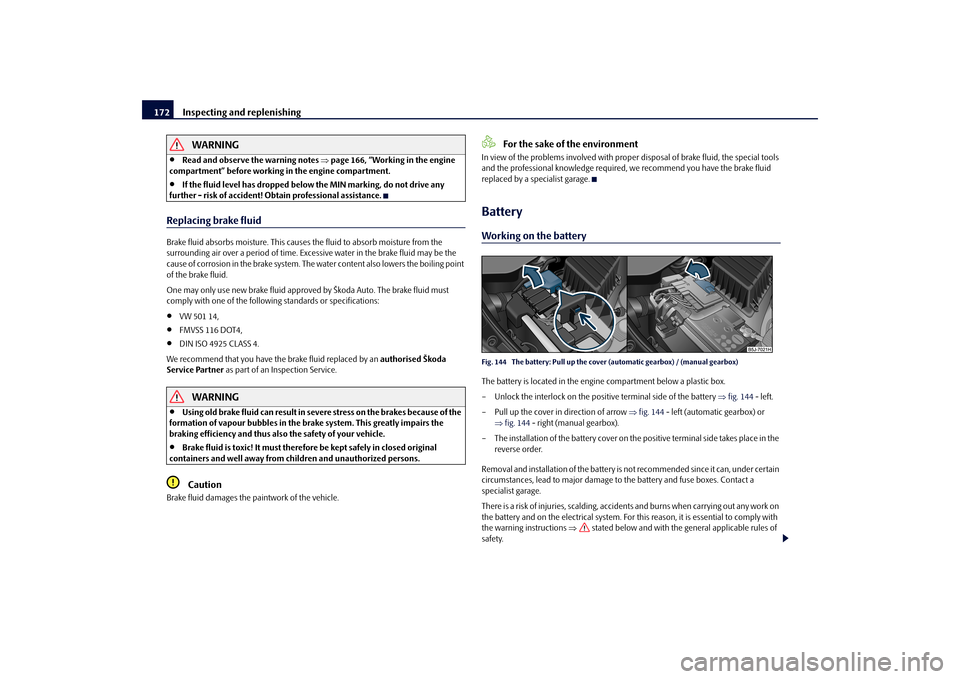
Inspecting and replenishing
172
WARNING
Read and observe the warning notes
page 166, “Working in the engine
compartment” before working in the engine compartment.
If the fluid level has dropped below the MIN marking, do not drive any
further - risk of accident! Obtain professional assistance.Replacing brake fluidBrake fluid absorbs moisture. This causes the fluid to absorb moisture from the surrounding air over a period of time. Excessive water in the brake fluid may be the cause of corrosion in the brake system. The
water content also lowers the boiling point
of the brake fluid. One may only use new brake fluid approved
by Škoda Auto. The brake fluid must
comply with one of the following standards or specifications:
VW 501 14,
FMVSS 116 DOT4,
DIN ISO 4925 CLASS 4.
We recommend that you have the brake fluid replaced by an
authorised Škoda
Service Partner
as part of an Inspection Service.
WARNING
Using old brake fluid can result in severe
stress on the brakes because of the
formation of vapour bubbles in the br
ake system. This greatly impairs the
braking efficiency and thus also the safety of your vehicle.
Brake fluid is toxic! It must therefor
e be kept safely in closed original
containers and well away from children and unauthorized persons.
Caution
Brake fluid damages the paintwork of the vehicle.
For the sake of the environment
In view of the problems involved with proper
disposal of brake fluid, the special tools
and the professional knowledge required, we recommend you have the brake fluid replaced by a specialist garage.BatteryWorking on the batteryFig. 144 The battery: Pull up the cove
r (automatic gearbox) / (manual gearbox)
The battery is located in the engi
ne compartment below a plastic box.
– Unlock the interlock on the positive terminal side of the battery
fig. 144
- left.
– Pull up the cover in direction of arrow
fig. 144
- left (automatic gearbox) or
fig. 144
- right (manual gearbox).
– The installation of the battery cover on th
e positive terminal side takes place in the
reverse order.
Removal and installation of the battery is
not recommended since it can, under certain
circumstances, lead to ma
jor damage to the battery and fuse boxes. Contact a
specialist garage. There is a risk of injuries, scalding, accidents and burns when carrying out any work on the battery and on the electrical system. For th
is reason, it is essential to comply with
the warning instructions
stated below and with the general applicable rules of
safety.
s3j8.a.book Page 172 Tuesday, April 20, 2010 1:10 PM
Page 179 of 244
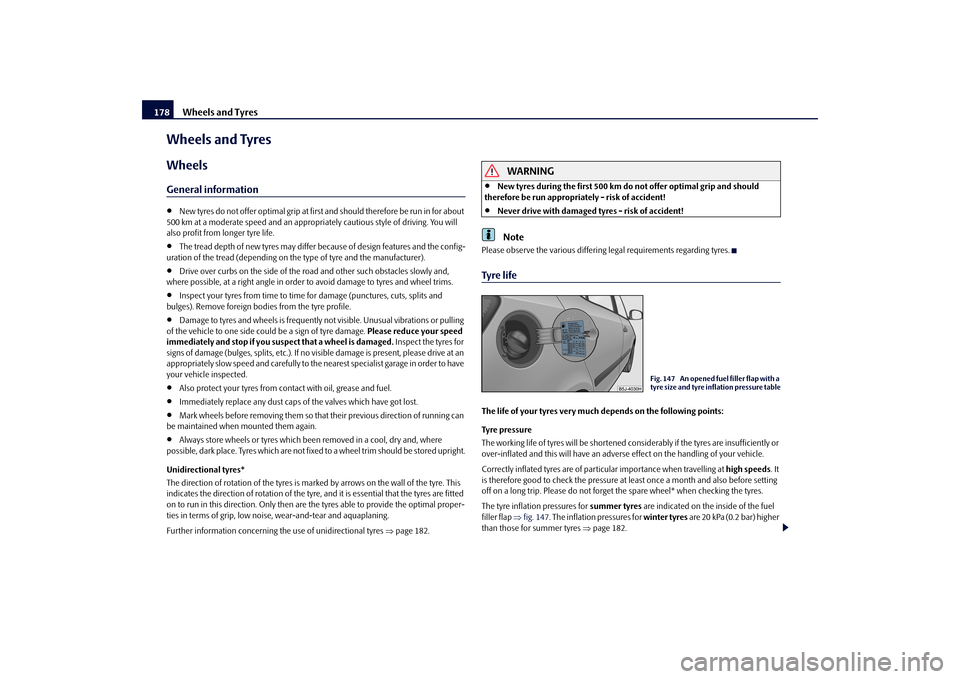
Wheels and Tyres
178
Wheels and TyresWheelsGeneral information
New tyres do not offer optimal grip at first and should therefore be run in for about
500 km at a moderate speed and an appropri
ately cautious style of driving. You will
also profit from longer tyre life.
The tread depth of new tyres may differ be
cause of design features and the config-
uration of the tread (depending on the type of tyre and the manufacturer).
Drive over curbs on the side of the road
and other such obstacles slowly and,
where possible, at a right angle in order
to avoid damage to tyres and wheel trims.
Inspect your tyres from time to time
for damage (punctures, cuts, splits and
bulges). Remove foreign bodies from the tyre profile.
Damage to tyres and wheels is frequently
not visible. Unusual vi
brations or pulling
of the vehicle to one side coul
d be a sign of tyre damage.
Please reduce your speed
immediately and stop if you su
spect that a wheel is damaged.
Inspect the tyres for
signs of damage (bulges, splits, etc.). If no
visible damage is present, please drive at an
appropriately slow speed and carefully to the nearest specialist garage in order to have your vehicle inspected.
Also protect your tyres from contact with oil, grease and fuel.
Immediately replace any dust caps of
the valves which have got lost.
Mark wheels before removing them so that
their previous dire
ction of running can
be maintained when mounted them again.
Always store wheels or tyres which been removed in a cool, dry and, where
possible, dark place. Tyres which are not fixed to a wheel trim should be stored upright. Unidirectional tyres* The direction of rotation of the tyres is mark
ed by arrows on the
wall of the tyre. This
indicates the direction of rotation of the tyre, and it is essential that the tyres are fitted on to run in this direction. Only then are
the tyres able to provide the optimal proper-
ties in terms of grip, low nois
e, wear-and-tear and aquaplaning.
Further information concerning th
e use of unidirectional tyres
page 182.
WARNING
New tyres during the first 500 km do not offer optimal grip and should
therefore be run appropriately - risk of accident!
Never drive with damaged tyres - risk of accident!Note
Please observe the various differing legal requirements regarding tyres.Ty re l i feThe life of your tyres very much depends on the following points: Tyre pressure The working life of tyres will be shortened considerably if the tyres are insufficiently or over-inflated and this will have an adverse
effect on the handli
ng of your vehicle.
Correctly inflated tyres are of particular importance when travelling at
high speeds
. It
is therefore good to check the pressure at
least once a month and also before setting
off on a long trip. Please do not forget the spare wheel* when checking the tyres. The tyre inflation pressures for
summer tyres
are indicated on the inside of the fuel
filler flap
fig. 147
. The inflation pressures for
winter tyres
are 20 kPa (0.2 bar) higher
than those for summer tyres
page 182.
Fig. 147 An opened fuel filler flap with a tyre size and tyre inflation pressure table
s3j8.a.book Page 178 Tuesday, April 20, 2010 1:10 PM
Page 182 of 244
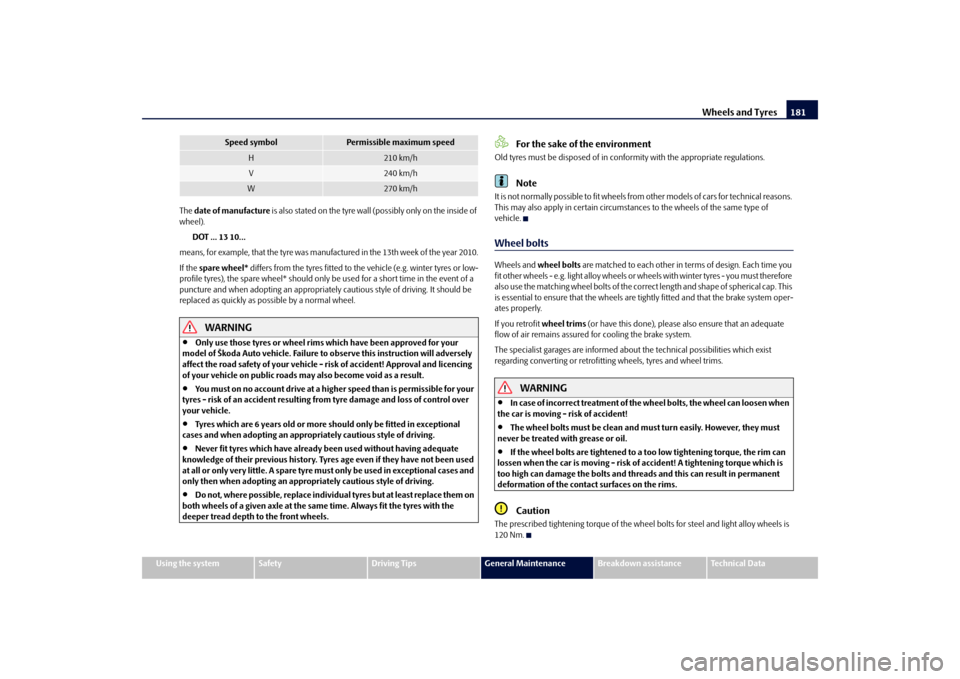
Wheels and Tyres
181
Using the system
Safety
Driving Tips
General Maintenance
Breakdown assistance
Technical Data
The
date of manufacture
is also stated on the tyre wall
(possibly only on the inside of
wheel).
DOT ... 13 10...
means, for example, that the tyre was ma
nufactured in the 13th week of the year 2010.
If the
spare wheel*
differs from the tyres fitted to the vehicle (e.g. winter tyres or low-
profile tyres), the spare wheel* should only be used for a short time in the event of a puncture and when adopting an appropriately
cautious style of driving. It should be
replaced as quickly as po
ssible by a normal wheel.
WARNING
Only use those tyres or wheel rims which have been approved for your
model of Škoda Auto vehicle. Failure to observe this instruction will adversely affect the road safety of your vehicle - risk of accident! Approval and licencing of your vehicle on public roads may also become void as a result.
You must on no account drive at a high
er speed than is permissible for your
tyres - risk of an accident resulting from tyre damage and loss of control over your vehicle.
Tyres which are 6 years old or more should only be fitted in exceptional
cases and when adopting an approp
riately cautious style of driving.
Never fit tyres which have already b
een used without having adequate
knowledge of their previous history. Tyre
s age even if they have not been used
at all or only very little. A spare tyre must only be used in exceptional cases and only then when adopting an appropriately cautious style of driving.
Do not, where possible, replace individu
al tyres but at least replace them on
both wheels of a given axle at the same time. Always fit the tyres with the deeper tread depth to the front wheels.
For the sake of the environment
Old tyres must be disposed
of in conformity with
the appropriate regulations.
Note
It is not normally possible to fit wheels from
other models of cars for technical reasons.
This may also apply in certain circumstances to the wheels of the same type of vehicle.Wheel boltsWheels and
wheel bolts
are matched to each other in terms of design. Each time you
fit other wheels - e.g. light alloy wheels or wheels with winter tyres - you must therefore also use the matching wheel bolts of the corr
ect length and shape of spherical cap. This
is essential to ensure that the wheels are tightly fitted and that the brake system oper- ates properly. If you retrofit
wheel trims
(or have this done), please
also ensure that an adequate
flow of air remains assured for cooling the brake system. The specialist garages are informed about the technical possibilities which exist regarding converting or retrofitting wheels, tyres and wheel trims.
WARNING
In case of incorrect treatment of the
wheel bolts, the wheel
can loosen when
the car is moving - risk of accident!
The wheel bolts must be clean and must
turn easily. However, they must
never be treated with grease or oil.
If the wheel bolts are tightened to a too low tightening torque, the rim can
lossen when the car is moving - risk of accident! A tightening torque which is too high can damage the bolts and threads and this can result in permanent deformation of the contac
t surfaces on the rims.
Caution
The prescribed tightening torque of the wh
eel bolts for steel and light alloy wheels is
120 Nm.
H
210 km/h
V
240 km/h
W
270 km/h
Speed symbol
Permissible maximum speed
s3j8.a.book Page 181 Tuesday, April 20, 2010 1:10 PM
Page 185 of 244
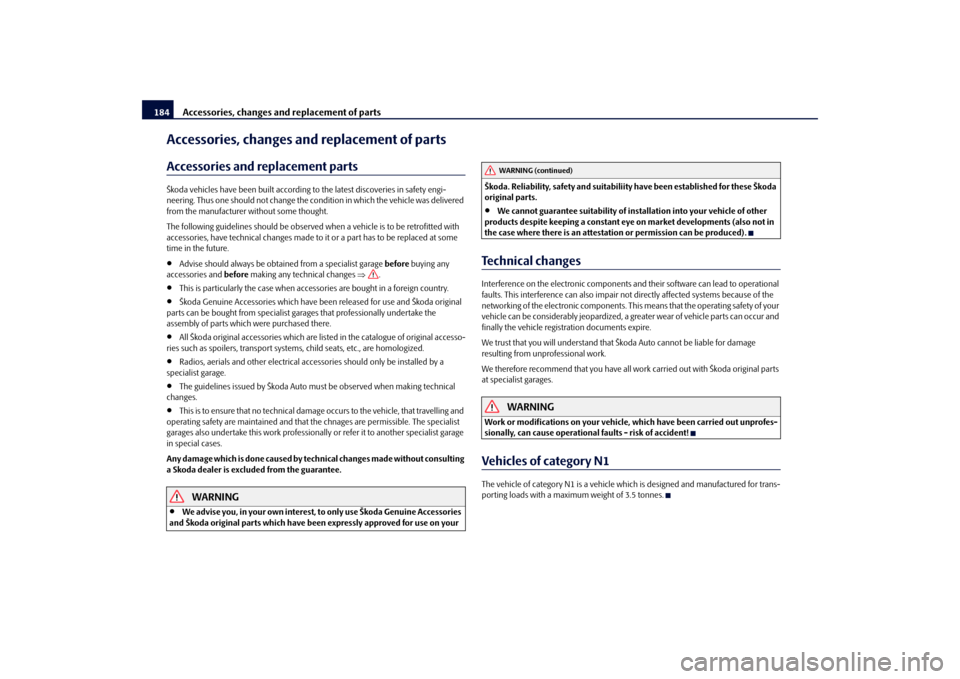
Accessories, changes and replacement of parts
184
Accessories, changes and replacement of partsAccessories and re
placement parts
Škoda vehicles have been built according to
the latest discoveries in safety engi-
neering. Thus one should not change the co
ndition in which the vehicle was delivered
from the manufacturer without some thought. The following guidelines should be observed
when a vehicle is to be retrofitted with
accessories, have technical ch
anges made to it or a part has to be replaced at some
time in the future.
Advise should always be obtained from a specialist garage
before
buying any
accessories and
before
making any technical changes
.
This is particularly the case when acce
ssories are bought in a foreign country.
Škoda Genuine Accessories wh
ich have been released for use and Škoda original
parts can be bought from specialist ga
rages that professionally undertake the
assembly of parts which were purchased there.
All Škoda original accessories which are listed in the catalogue of original accesso-
ries such as spoilers, transport systems, child seats, etc., are homologized.
Radios, aerials and other electrical acce
ssories should only be installed by a
specialist garage.
The guidelines issued by Škoda Auto mu
st be observed when
making technical
changes.
This is to ensure that no technical damage
occurs to the vehicle, that travelling and
operating safety are maintained and that the chnages are permissible. The specialist garages also undertake this work professionally
or refer it to another specialist garage
in special cases. Any damage which is done caused by tech
nical changes made without consulting
a Skoda dealer is exclud
ed from the guarantee.
WARNING
We advise you, in your own interest, to only use Škoda Genuine Accessories
and Škoda original parts which have been
expressly approved for use on your
Škoda. Reliability, safety and suitabilii
ty have been established for these Škoda
original parts.
We cannot guarantee suitability of installation into your vehicle of other
products despite keeping a constant eye
on market developments (also not in
the case where there is an attestation or permission can be produced).Technical changesInterference on the electronic components and their software can lead to operational faults. This interference can also impair no
t directly affected sy
stems because of the
networking of the electronic components. This
means that the operating safety of your
vehicle can be considerably jeopardized, a
greater wear of vehicle parts can occur and
finally the vehicle registration documents expire. We trust that you will understand that Šk
oda Auto cannot be liable for damage
resulting from unprofessional work. We therefore recommend that you have all wo
rk carried out with Škoda original parts
at specialist garages.
WARNING
Work or modifications on your vehicle, which have been carried out unprofes-sionally, can cause operational faults - risk of accident!Vehicles of category N1The vehicle of category N1 is a vehicle wh
ich is designed and manufactured for trans-
porting loads with a maximum weight of 3.5 tonnes.
WARNING (continued)
s3j8.a.book Page 184 Tuesday, April 20, 2010 1:10 PM
Page 188 of 244
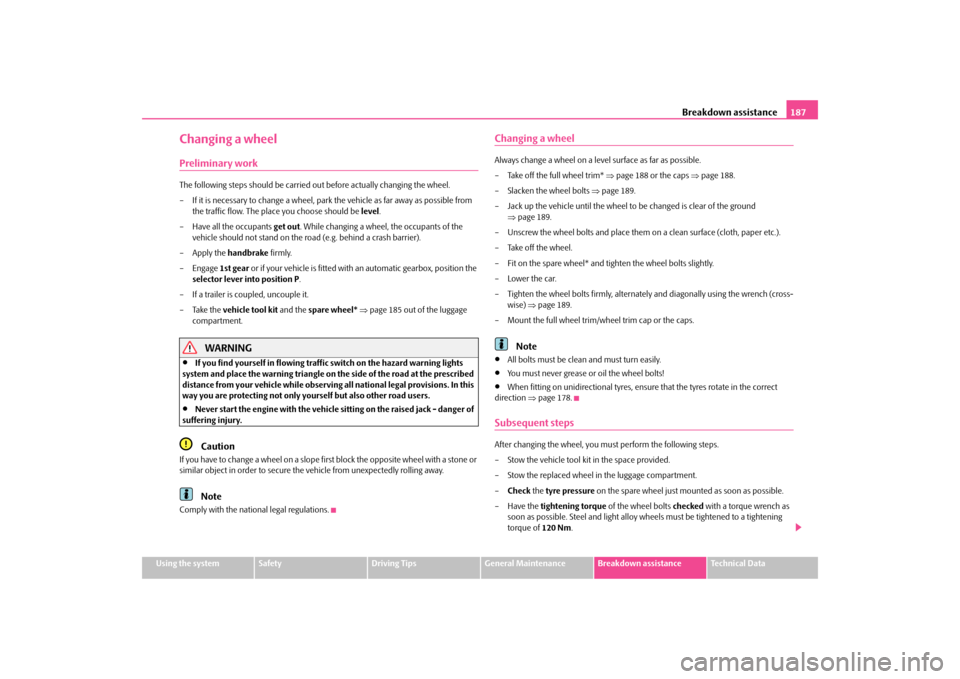
Breakdown assistance
187
Using the system
Safety
Driving Tips
General Maintenance
Breakdown assistance
Technical Data
Changing a wheelPreliminary workThe following steps should be carried ou
t before actually changing the wheel.
– If it is necessary to change a wheel, park
the vehicle as far aw
ay as possible from
the traffic flow. The place you choose should be
level
.
– Have all the occupants
get out
. While changing a wheel, the occupants of the
vehicle should not stand on the ro
ad (e.g. behind a crash barrier).
– Apply the
handbrake
firmly.
–Engage
1st gear
or if your vehicle is fitted with
an automatic gearbox, position the
selector lever into position P
.
– If a trailer is coupled, uncouple it.– Take the
vehicle tool kit
and the
spare wheel*
page 185 out of the luggage
compartment.
WARNING
If you find yourself in flowing traffic switch on the hazard warning lights
system and place the warning triangle on
the side of the road at the prescribed
distance from your vehicle while observing all national legal provisions. In this way you are protecting not only yourself but also other road users.
Never start the engine with the vehicle si
tting on the raised
jack - danger of
suffering injury.
Caution
If you have to change a wheel on a slope first block the opposite wheel with a stone or similar object in order to secure the
vehicle from unexpectedly rolling away.
Note
Comply with the national legal regulations.
Changing a wheelAlways change a wheel on a level surface as far as possible. – Take off the full wheel trim*
page 188 or the caps
page 188.
– Slacken the wheel bolts
page 189.
– Jack up the vehicle until the wheel to
be changed is clear of the ground
page 189.
– Unscrew the wheel bolts and place them
on a clean surface (cloth, paper etc.).
– Take off the wheel.– Fit on the spare wheel* and tighten the wheel bolts slightly.– Lower the car.– Tighten the wheel bolts firmly, alternatel
y and diagonally using the wrench (cross-
wise)
page 189.
– Mount the full wheel trim/wheel trim cap or the caps.
Note
All bolts must be clean and must turn easily.
You must never grease or oil the wheel bolts!
When fitting on unidirectiona
l tyres, ensure that the tyres rotate in the correct
direction
page 178.
Subsequent stepsAfter changing the wheel, you mu
st perform the following steps.
– Stow the vehicle tool kit in the space provided.– Stow the replaced wheel in the luggage compartment.–
Check
the
tyre pressure
on the spare wheel just mounted as soon as possible.
– Have the
tightening torque
of the wheel bolts
checked
with a torque wrench as
soon as possible. Steel and light alloy wheels must be tightened to a tightening torque of
120 Nm
.
s3j8.a.book Page 187 Tuesday, April 20, 2010 1:10 PM
Page 194 of 244
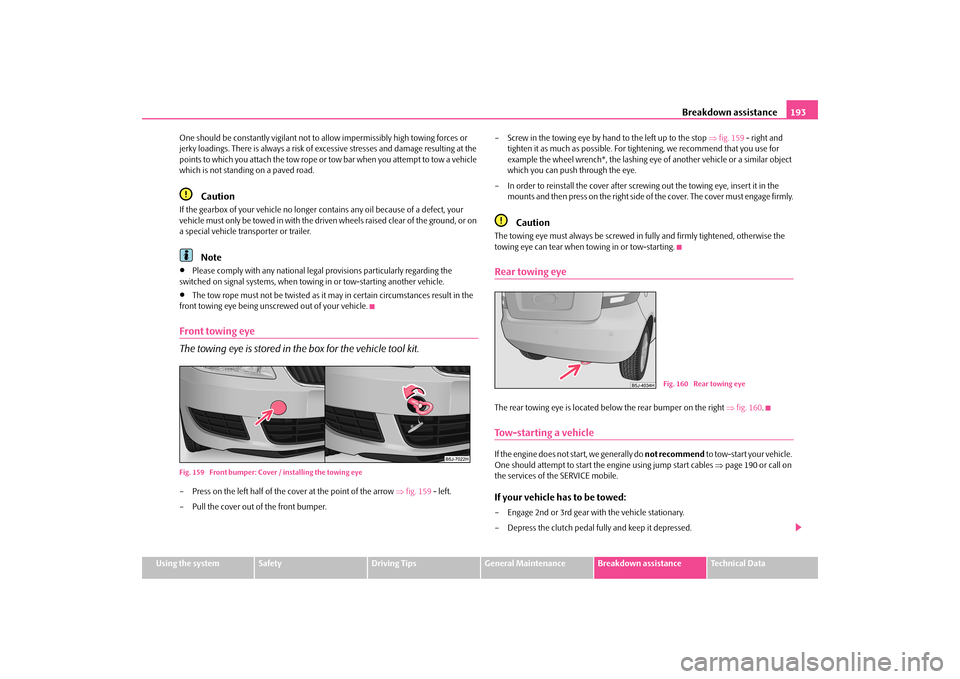
Breakdown assistance
193
Using the system
Safety
Driving Tips
General Maintenance
Breakdown assistance
Technical Data
One should be constantly vigi
lant not to allow impermissi
bly high towing forces or
jerky loadings. There is always a risk of excessive stresses and damage resulting at the points to which you attach the tow rope or
tow bar when you attempt to tow a vehicle
which is not standing on a paved road.
Caution
If the gearbox of your vehicle no longer
contains any oil because of a defect, your
vehicle must only be towed in with the driven wheels raised clear of the ground, or on a special vehicle transporter or trailer.
Note
Please comply with any national legal provisions particularly regarding the
switched on signal systems, when towi
ng in or tow-starting another vehicle.
The tow rope must not be twisted as it ma
y in certain circumstances result in the
front towing eye being unscrewed out of your vehicle.Front towing eye The towing eye is stored in the box for the vehicle tool kit.Fig. 159 Front bumper: Cover
/ installing the towing eye
– Press on the left half of the cover at the point of the arrow
fig. 159
- left.
– Pull the cover out of the front bumper.
– Screw in the towing eye by hand to the left up to the stop
fig. 159
- right and
tighten it as much as po
ssible. For tightening, we
recommend that you use for
example the wheel wrench*, the lashing eye of another vehicle or a similar object which you can push through the eye.
– In order to reinstall the cover after screwing out the towing eye, insert it in the
mounts and then press on the right side of the cover. The cover must engage firmly.Caution
The towing eye must always be screwed in
fully and firmly tightened, otherwise the
towing eye can tear when towing in or tow-starting.Rear towing eyeThe rear towing eye is located below the rear bumper on the right
fig. 160
.
Tow-starting a vehicleIf the engine does not start, we generally do
not
recommend
to tow-start your vehicle.
One should attempt to start the engine using jump start cables
page 190 or call on
the services of the SERVICE mobile.If your vehicle has to be towed:– Engage 2nd or 3rd gear with the vehicle stationary. – Depress the clutch pedal fu
lly and keep it depressed.
Fig. 160 Rear towing eye
s3j8.a.book Page 193 Tuesday, April 20, 2010 1:10 PM
Page 195 of 244
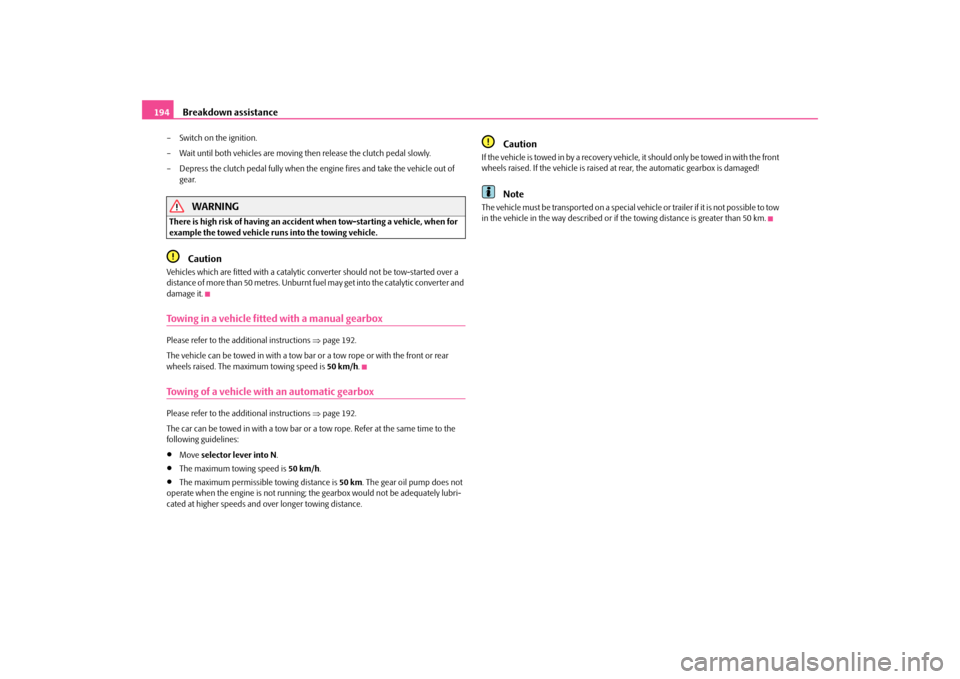
Breakdown assistance
194
– Switch on the ignition. – Wait until both vehicles are moving
then release the clutch pedal slowly.
– Depress the clutch pedal fully when the engine fires and take the vehicle out of
gear.
WARNING
There is high risk of having an accident when tow-starting a vehicle, when for example the towed vehicle ru
ns into the towing vehicle.
Caution
Vehicles which are fitted with a catalytic
converter should not be tow-started over a
distance of more than 50 metres. Unburnt fu
el may get into the catalytic converter and
damage it.Towing in a vehicle fitted with a manual gearboxPlease refer to the additional instructions
page 192.
The vehicle can be towed in with a tow bar
or a tow rope or with the front or rear
wheels raised. The maximum towing speed is
50 km/h
.
Towing of a vehicle with an automatic gearboxPlease refer to the additional instructions
page 192.
The car can be towed in with a tow bar or
a tow rope. Refer at the same time to the
following guidelines:
Move
selector lever into N
.
The maximum towing speed is
50 km/h
.
The maximum permissible
towing distance is
50 km
. The gear oil pump does not
operate when the engine is not running; th
e gearbox would not be
adequately lubri-
cated at higher speeds and ov
er longer towing distance.
Caution
If the vehicle is towed in by a recovery vehicle,
it should only be towed in with the front
wheels raised. If the vehicle is raised
at rear, the automatic gearbox is damaged!
Note
The vehicle must be transported on a special vehicle or trailer if it is not possible to tow in the vehicle in the way described or if th
e towing distance is greater than 50 km.
s3j8.a.book Page 194 Tuesday, April 20, 2010 1:10 PM